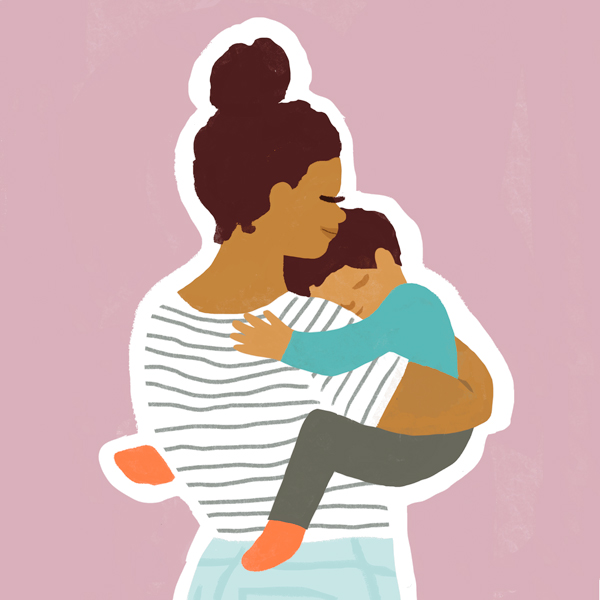How to handle nightmares in young children
Nightmares are a common part of childhood development, especially in young children who are still exploring and understanding the world around them. While having the occasional nightmare is normal, these experiences can be frightening and destabilizing for both children and their parents. Understanding why nightmares occur and how to effectively manage them can help parents provide the emotional support their children need and, in turn, promote a more peaceful sleep environment. (Read also: How to Teach a Child to Sleep Alone: A Complete Guide for Parents)
Article Topics
- Common causes of nightmares in children
- How to react when a nightmare occurs?
- Strategies to prevent nightmares
- Techniques to calm night fears
- When to seek professional help
- How to involve the child in managing his nightmares
- Sleep disorders in children: symptoms and treatments
- Conclusion
Common causes of nightmares in children
Before we address how to deal with nightmares, it’s important to understand what can trigger them. In young children, nightmares are often a manifestation of fears or anxieties. For example, they may be related to major life changes, such as starting school or the arrival of a new sibling. Everyday experiences, such as watching a scary TV show or a book with disturbing images, can also influence the content of dreams.
Another factor to consider is children’s cognitive development . As children grow, their imagination expands and they may have difficulty distinguishing between what is real and what is not. This can cause everyday situations to become scary elements at night. Additionally, stressful situations at home, such as family conflicts or a disordered sleep routine , can increase the likelihood that a child will experience nightmares more frequently.
How to react when a nightmare occurs?
When a child is startled awake by a nightmare, the way parents react can have a significant impact on how the child processes the experience. It is important for parents to remain calm and approach their child with empathy and comfort. Young children, due to their limited understanding of reality, may believe that the nightmare was real, so they need reassurance from parents that they are safe.
Listening to the child as he or she recounts his or her nightmare, without minimizing his or her emotions, is critical. Phrases like “It was just a dream” may seem well-intentioned, but they can invalidate the child’s fear. Instead, it’s better to use phrases like “I understand that you felt scared, but you’re safe now, I’m here with you.” This type of response not only calms the child, but also reinforces the emotional connection with the parent, providing a sense of security.
Strategies to prevent nightmares
While nightmares can’t always be avoided, there are several steps parents can take to reduce their frequency. Establishing a regular sleep routine is one of the most effective methods. Young children thrive on consistency, and a set bedtime can help improve sleep quality. Including relaxing activities in the nighttime routine, such as reading a quiet book or taking a warm bath, can also contribute to deeper, less interrupted rest.
Avoiding exposure to disturbing content before bed is equally crucial. It’s advisable to limit screen time and choose shows or books that aren’t visually or emotionally intense. Additionally, creating a comfortable sleep environment, with soft lighting and a comfortable temperature, can make a child feel more secure at bedtime, which in turn could decrease the likelihood of nightmares occurring.
Techniques to calm night fears
When a child has recurring fears that lead to nightmares, it is helpful to teach them techniques to manage those fears. One simple and effective approach is “dream reimagining.” This technique involves asking the child to retell the nightmare and then guiding them to modify the ending of the story to make it less scary.
For example, if the child has a dream about a monster, he or she may be encouraged to imagine the monster becoming a friend or defeating it with superpowers. This type of intervention not only helps reduce fear, but also gives the child a sense of control over his or her dreams.
Another helpful technique is to provide comfort objects, such as a stuffed animal or a favorite blanket, that the child can associate with safety and comfort. Many children find comfort in having a familiar object nearby that reminds them of their parents’ protection. A “night light” can also be used if the fear of the dark is related to nightmares.
When to seek professional help
In most cases, nightmares in young children are occasional episodes that can be managed at home with the strategies mentioned above. However, if nightmares become recurrent, significantly disrupting the child’s sleep and well-being, it may be necessary to seek professional help. Frequent nightmares may be a sign of underlying stress, anxiety, or, in rare cases, a sleep disorder that requires medical or psychological intervention.
A pediatrician or child psychologist can help assess whether there are deeper factors contributing to nightmares and provide specific guidance on how to treat them. Additionally, in situations where nightmares are associated with traumatic events, early intervention can be crucial to the child’s emotional well-being.
How to involve the child in managing his nightmares
Involving your child in managing his nightmares can give him a sense of empowerment and reduce his nighttime anxiety. One effective way to do this is by creating “safety rituals” before bed. This can include simple activities, such as checking the room together to make sure there are no “monsters,” or allowing your child to choose a quiet story to read before bed. By including your child in this process, you give him control over his environment, which can make him feel more secure.
Another technique is to encourage the child to draw his or her nightmares during the day and then discuss the drawing together. This can help the child express his or her fears in a controlled manner and create an opportunity for the parent to offer comfort and reassurance.
Sleep disorders in children: symptoms and treatments
Sleep disorders in children are more common than you might think and can affect their overall well-being. Some of the most common symptoms include difficulty falling asleep, frequent awakenings during the night, excessive daytime sleepiness, and unusual behaviors such as sleepwalking or night terrors.
Children with these problems often show irritability, difficulty concentrating, and poor performance at school. It is important for parents to be alert to these signs, as a lack of adequate sleep can affect a child’s physical and emotional development.
One of the most common sleep disorders in children is insomnia, which can be related to anxiety, stress, or poor sleep habits. Another common condition is sleep apnea, a disorder in which breathing is briefly interrupted during sleep, which can cause repeated awakenings and poor rest.
Night terrors , on the other hand, are episodes of screaming or intense crying that occur during deep sleep, and although they may be disturbing for parents, the child usually does not remember the event.
Treatment for sleep disorders in children depends on the underlying cause. For insomnia, establishing a consistent sleep routine and a calm environment before bed can be helpful.
In cases of sleep apnea, medical treatment may be necessary, such as the use of devices to keep the airway open at night. Night terrors often improve over time, but parents can minimize their impact by creating a safe environment and ensuring that the child gets enough sleep. If problems persist, it is advisable to consult a sleep specialist for a proper diagnosis and professional guidance.
Conclusion
Nightmares in young children are common, but they can be frightening for both children and their parents. By understanding the causes of nightmares and implementing practical strategies to calm them, parents can help their children feel more secure and reduce the frequency of these nighttime episodes.
It is critical for parents to address nightmares with patience and empathy, creating a calm sleeping environment and reinforcing a child’s sense of security. While most nightmares can be managed at home, parents should be on the lookout for signs of deeper problems that may require professional intervention.





